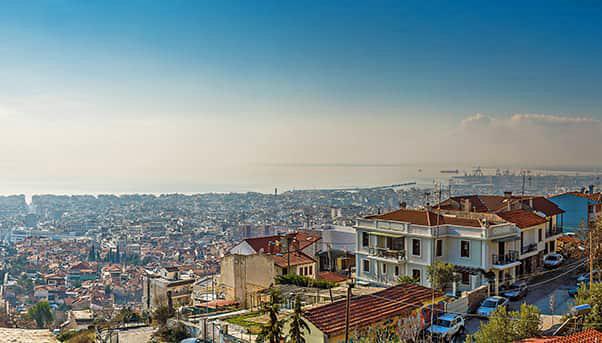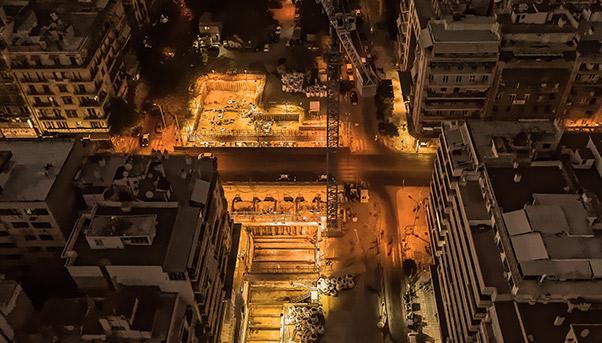
Greece is one of those countries where a construction site can easily turn into an archaeological dig. Wherever a tractor digs a hole, it runs the chance of uncovering a relic or a ruin from an ancient civilization.
That is what is happening in Thessaloniki, where the country’s second largest city of some one million inhabitants is overseeing the construction of its first metro line. As workers excavated the locations for 13 stations along the length of the 9.6-kilometre line, they discovered successive layers of the city’s engrossing history. The same occurred in Rome, where work on a metro line uncovered new parts of ancient Rome, forcing the project’s developers to revise plans for many stations.
In Thessaloniki, what was unearthed – the most noteworthy being a stretch of marble slabs belonging to the main Roman road known as decumanus maximum – complicated the already difficult task of building a metro line through the heart of Thessaloniki, the densest and most congested part of the city. Not only did they have to be careful not to disrupt its bustling activity, but also avoid damaging the ancient remains that lay beneath it. In short, they had to be as light in their touch as their machinery was heavy.
The number of uncovered archaeological sites has risen since the beginning of the project. Covering a combined area of about 30,000 square meters, they have become the largest of their kind in Thessaloniki.
Thessaloniki: the metro line construction works reveal history
At a cost of €1.2 billion, the Thessaloniki Metro is Greece’s biggest public work. In addition to the underground line and its 13 stations, it includes a depot for rolling stock and a workshop for maintaining and repairing mechanical and electrical equipment.
By complimenting public transport services on the streets of the city, the metro will help reduce the number of cars in circulation. Once it is fully operational, it will carry 18,000 passengers per hour in each direction at a frequency of 90 seconds at peak times. The stations will be equipped with screen doors on the platforms for the safety of passengers, sliding open only at the arrival of the driverless trains.
The project’s completion is set for 2020.
Minimising Risk
In order to avoid destroying any potential remains of ancient civilizations under the city’s surface, Salini Impregilo and its joint-venture partners went as deep as 20 metres to drill the metro line’s parallel tunnels. The depth at which they worked with their tunnel-boring machines also minimised the risk of rendering unstable the foundations of buildings located above their heads.
But the workers who handled the tractors and other excavating equipment above ground were the ones who had to be extra careful. As they dug as deep as 10 metres into the ground to make way for the stations, they uncovered hidden treasures that revealed the city’s rich past. This has made the next 10 metres of digging more complicated. At the site of the future Venizelos station, for instance, engineers are looking at how best to dig around their findings to preserve them and let the archaeologists do their work.

Another station, Demokratias, has actually been relocated by about 10 metres to accommodate the archaeological work on a wall from the Byzantine era that was found during the dig.
Demokratias, Venizelos and a future third station called Aghia Sofia have been declared “high archaeological risk” by the metro operator, Attiko Metro, meaning the discoveries made at these locations are of the upmost historic importance. Aghia Sofia is where the decumanus maximum was found. Other discoveries include building foundations from the early Christian era, a complex of sewage pipes, a Byzantine market with shops, and minor artifacts like pendant crosses, bracelets and silver rings.
Cultural Heritage
Founded in 315 B.C. by a Macedonian king, Thessaloniki was to become a provincial capital of the Roman Empire. It rose in importance as a trade hub between Byzantium to the east and Dyrrhachium to the west. It would be raided by Goths, Slavs, Bulgarians and other marauding forces throughout the centuries before falling under the dominion of the Ottomans. A harbour for the Balkans, it had the largest Jewish population in the empire. The receding influence of Istanbul would eventually see the city join Greece in 1913.
Working closely with the Ministry of Culture, Attiko Metro plans to put on display these discoveries in the stations for commuters to see, converting the public spaces into partial museums. «The benefit from the construction of the Project shall be double for the city of Thessaloniki: speed, safety, comfort and reliability using the best public transportation mode and invaluable knowledge about its cultural heritage,» Attiko Metro says on its website.

